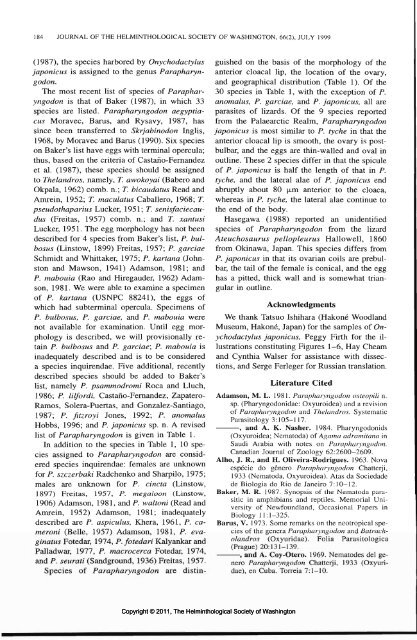The Helminthological Society of Washington - Peru State College
The Helminthological Society of Washington - Peru State College
The Helminthological Society of Washington - Peru State College
You also want an ePaper? Increase the reach of your titles
YUMPU automatically turns print PDFs into web optimized ePapers that Google loves.
184 JOURNAL OF THE HELMINTHOLOGICAL SOCIETY OF WASHINGTON, 66(2), JULY 1999<br />
(1987), the species harbored by Onychodactylus<br />
japonicus is assigned to the genus Parapharyngodon.<br />
<strong>The</strong> most recent list <strong>of</strong> species <strong>of</strong> Parapharyngodon<br />
is that <strong>of</strong> Baker (1987), in which 33<br />
species are listed. Parapharyngodon aegyptiacus<br />
Moravec, Barus, and Rysavy, 1987, has<br />
since been transferred to Skrjabinodon Inglis,<br />
1968, by Moravec and Barus (1990). Six species<br />
on Baker's list have eggs with terminal opercula;<br />
thus, based on the criteria <strong>of</strong> Castano-Fernandez<br />
et al. (1987), these species should be assigned<br />
to <strong>The</strong>landros, namely, T. awokoyai (Babero and<br />
Okpala, 1962) comb, n.; T. bicaudatus Read and<br />
Amrein, 1952; T. maculatus Caballero, 1968; T.<br />
pseudothaparius Lucker, 1951; T. senisfaciecaudus<br />
(Freitas, 1957) comb, n.; and T. xantusi<br />
Lucker, 1951. <strong>The</strong> egg morphology has not been<br />
described for 4 species from Baker's list, P. bulbosus<br />
(Linstow, 1899) Freitas, 1957; P. garciae<br />
Schmidt and Whittaker, 1975; P. kartana (Johnston<br />
and Mawson, 1941) Adamson, 1981; and<br />
P. mabouia (Rao and Hiregauder, 1962) Adamson,<br />
1981. We were able to examine a specimen<br />
<strong>of</strong> P. kartana (USNPC 88241), the eggs <strong>of</strong><br />
which had subterminal opercula. Specimens <strong>of</strong><br />
P. bulbosus, P. garciae, and P. mabouia were<br />
not available for examination. Until egg morphology<br />
is described, we will provisionally retain<br />
P. bulbosus and P. garciae; P. mabouia is<br />
inadequately described and is to be considered<br />
a species inquirendae. Five additional, recently<br />
described species should be added to Baker's<br />
list, namely P. psamrnodromi Roca and Lluch,<br />
1986; P. lilfordi, Castano-Fernandez, Zapatero-<br />
Ramos, Solera-Puertas, and Gonzalez-Santiago,<br />
1987; P. fitzroyi Jones, 1992; P. anomalus<br />
Hobbs, 1996; and P. japonicus sp. n. A revised<br />
list <strong>of</strong> Parapharyngodon is given in Table 1.<br />
In addition to the species in Table 1, 10 species<br />
assigned to Parapharyngodon are considered<br />
species inquirendae: females are unknown<br />
for P. szczerbaki Radchenko and Sharpilo, 1975;<br />
males are unknown for P. cincta (Linstow,<br />
1897) Freitas, 1957, P. megaloon (Linstow,<br />
1906) Adamson, 1981, and P. waltoni (Read and<br />
Amrein, 1952) Adamson, 1981; inadequately<br />
described are P. aspiculus, Khera, 1961, P. cameroni<br />
(Belle, 1957) Adamson, 1981, P. evaginatus<br />
Fotedar, 1974, P. fotedari Kalyankar and<br />
Palladwar, 1977, P. macrocerca Fotedar, 1974,<br />
and P. seurati (Sandground, 1936) Freitas, 1957.<br />
Species <strong>of</strong> Parapharyngodon are distinguished<br />
on the basis <strong>of</strong> the morphology <strong>of</strong> the<br />
anterior cloacal lip, the location <strong>of</strong> the ovary,<br />
and geographical distribution (Table 1). Of the<br />
30 species in Table 1, with the exception <strong>of</strong> P.<br />
anomalus, P. garciae, and P. japonicus, all are<br />
parasites <strong>of</strong> lizards. Of the 9 species reported<br />
from the Palaearctic Realm, Parapharyngodon<br />
japonicus is most similar to P. tyche in that the<br />
anterior cloacal lip is smooth, the ovary is postbulbar,<br />
and the eggs are thin-walled and oval in<br />
outline. <strong>The</strong>se 2 species differ in that the spicule<br />
<strong>of</strong> P. japonicus is half the length <strong>of</strong> that in P.<br />
tyche, and the lateral alae <strong>of</strong> P. japonicus end<br />
abruptly about 80 (Jim anterior to the cloaca,<br />
whereas in P. tyche, the lateral alae continue to<br />
the end <strong>of</strong> the body.<br />
Hasegawa (1988) reported an unidentified<br />
species <strong>of</strong> Parapharyngodon from the lizard<br />
Ateuchosaurus pellopleurus Hallowell, 1860<br />
from Okinawa, Japan. This species differs from<br />
P. japonicus in that its ovarian coils are prebulbar,<br />
the tail <strong>of</strong> the female is conical, and the egg<br />
has a pitted, thick wall and is somewhat triangular<br />
in outline.<br />
Acknowledgments<br />
We thank Tatsuo Ishihara (Hakone Woodland<br />
Museum, Hakone, Japan) for the samples <strong>of</strong> Onychodactylus<br />
japonicus, Peggy Firth for the illustrations<br />
constituting Figures 1—6, Hay Cheam<br />
and Cynthia Walser for assistance with dissections,<br />
and Serge Ferleger for Russian translation.<br />
Literature Cited<br />
Adamson, M. L. 1981. Parapharyngodon osteopili n.<br />
sp. (Pharyngodonidae: Oxyuroidea) and a revision<br />
<strong>of</strong> Parapharyngodon and <strong>The</strong>landros. Systematic<br />
Parasitology 3:105-117.<br />
, and A. K. Nasher. 1984. Pharyngodonids<br />
(Oxyuroidea; Nematoda) <strong>of</strong> Agama adramitana in<br />
Saudi Arabia with notes on Parapharyngodon.<br />
Canadian Journal <strong>of</strong> Zoology 62:2600-2609.<br />
Alho, J. R., and H. Oliveira-Rodrigues. 1963. Nova<br />
especie do genero Parapharyngodon Chatterji,<br />
1933 (Nematoda, Oxyuroidea). Atas da Sociedade<br />
de Biologia do Rio de Janeiro 7:10-12.<br />
Baker, M. R. 1987. Synopsis <strong>of</strong> the Nematoda parasitic<br />
in amphibians and reptiles. Memorial University<br />
<strong>of</strong> Newfoundland, Occasional Papers in<br />
Biology 11:1-325.<br />
Barus, V. 1973. Some remarks on the neotropical species<br />
<strong>of</strong> the genera Parapharyngodon and Batracholandros<br />
(Oxyuridae). Folia Parasitologica<br />
(Prague) 20:131-139.<br />
, and A. Coy-Otero. 1969. Nematodes del genero<br />
Parapharyngodon Chatterji, 1933 (Oxyuridae),<br />
en Cuba. Torreia 7:1-10.<br />
Copyright © 2011, <strong>The</strong> <strong>Helminthological</strong> <strong>Society</strong> <strong>of</strong> <strong>Washington</strong>
















